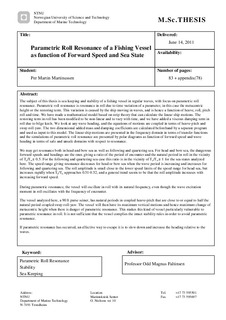| dc.description.abstract | The subject of this thesis is sea keeping and stability of a fishing vessel in regular waves, with focus on parametric roll resonance. Parametric roll resonance is resonance in roll due to time variation of a parameter, in this case the metacentric height or the restoring term. This variation is caused by the ship moving in waves, and is hence a function of heave, roll, pitch roll and time. We have made a mathematical model based on strip theory that can calculate the linear ship motions. The restoring term in roll has been modified to be non-linear and to vary with time, and we have added a viscous damping term in roll due to bilge keels. We look at any wave heading, and the equations of motions are coupled in terms of heave-pitch and sway-roll-yaw. The two dimensional added mass and damping coefficients are calculated beforehand by a separate program and used as input to this model. The linear ship motions are presented in the frequency domain in terms of transfer functions and the simulations of parametric roll resonance are presented by polar diagrams as function of forward speed and wave heading in terms of safe and unsafe domains with respect to resonance.
We may get resonance both in head and bow sea as well as following and quartering sea. For head and bow sea, the dangerous forward speeds and headings are the ones giving a ratio of the period of encounter and the natural period in roll in the vicinity of Te/Tn≈0.5. For the following and quartering sea case this ratio is in the vicinity of Te/Tn≈1 for the sea states analyzed here. The speed range giving resonance decreases for head or bow sea when the wave period is increasing and increases for following and quartering sea. The roll amplitude is small close to the lower speed limits of the speed range for head sea, but increases rapidly when Te/Tn approaches 0.51-0.52, and a general trend seems to be that the roll amplitude increases with increasing forward speed.
During parametric resonance, the vessel will oscillate in roll with its natural frequency, even though the wave excitation moment in roll oscillates with the frequency of encounter. The vessel analyzed here, a 90 ft purse seiner, has natural periods in coupled heave-pitch that are close to or equal to half the natural period coupled sway-roll-yaw. The vessel will then have its maximum vertical motions and hence maximum change of metacentric height when there is danger of parametric resonance. This makes this kind of vessel particularly vulnerable to parametric resonance in roll. It is not sufficient that the vessel complies the intact stability rules in order to avoid parametric resonance.
If parametric resonance has occurred, an effective way to escape it is to slow down and increase the heading relative to the waves.
| nb_NO |
